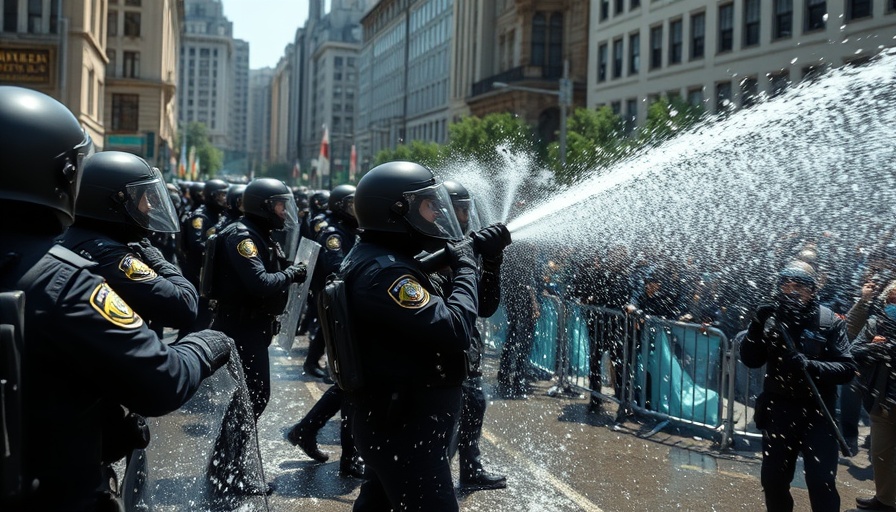
Unraveling the Crisis: Protests Erupt in Nepal
In a dramatic turn of events, the political landscape of Nepal has been shattered as police opened fire on protesters in Kathmandu on Monday, resulting in the tragic loss of at least 17 lives. This alarming act of violence came in the wake of widespread demonstrations against government corruption and a controversial ban on social media platforms—decisions that have ignited public outrage across the capital and beyond.
In 'Nepal police kills at least 17 people protesting corruption and social media ban', the discussion dives into the intersection of governance and civil rights, exploring key insights that sparked deeper analysis on our end.
The protests, driven predominantly by the Gen Z demographic, demonstrate a generational shift in Nepal's civic activism. Thousands of demonstrators flocked to the streets, voicing their frustration not only at the restrictive policies of their government but also at what they perceive as an increasing authoritarian grip on their freedoms.
A Catalyst for Change: Understanding the Root Causes
The unrest began as the Nepalese government enacted measures to ban major social media platforms such as Facebook, X, and YouTube, citing a lack of registration and accountability to local laws. However, this explanation has fallen flat for many citizens who interpret it as an attempt to suppress dissent and avoid scrutiny over pervasive corruption. The government's decision to silence voices of dissent amid economic grievances only serves to exacerbate feelings of discontent.
Corruption in Nepal has long been a thorny issue. According to numerous reports, it hampers economic growth, undermines public trust, and affects service delivery in various sectors. This backdrop has provided fertile ground for the current protests, illustrating the frustrations brewing beneath the surface in a nation seeking accountability.
The Human Cost: Lives and Injuries
The violence unleashed by the police on protesters has drawn condemnation both locally and internationally. Eyewitness accounts describe scenes of chaos and horror, with many demonstrators reportedly shot in critical areas such as the head and chest. Medical professionals at the National Trauma Center confirmed that more than 145 people have sustained injuries, highlighting the severe human cost of this political showdown.
Physicians treating the wounded have stated that many injuries are consistent with high-velocity impacts, indicating the potential use of live ammunition. Such confrontations raise essential questions regarding the use of force in policing, especially in the context of public demonstrations.
The Role of Technology: A Double-edged Sword
As protesters chant slogans like "stop corruption, not social media," it becomes clear that technology plays a crucial role in shaping modern activism. While the government’s ban on social media may have been intended to obstruct communication among activists, it has also galvanized them. Social media platforms have historically provided a space for organizing and voicing dissent, leading many to challenge government authority in unprecedented ways.
However, in imposing such bans, authorities risk isolating themselves further from the populace, pushing citizens to seek alternative means of expression and engagement while potentially stoking further unrest.
Global Perspectives and Implications
The events in Nepal resonate with a broader narrative across similar global movements where governments have enacted restrictive measures in response to civil unrest. The use of force against protesters, especially during epochs of digital communication, illustrates the complex dynamics at play as individuals navigate their rights within modern governance frameworks.
As news of these protests and their violent turn circulates on platforms like Africanews and other international outlets, it becomes essential to recognize the interplay between local action and global discourse on human rights and governance.
What’s Next for Nepal?
The situation in Nepal remains tenuous, with the government subsequently declaring a curfew around key administrative areas, signaling a further escalation of tensions. As smaller protests continue to emerge, the question arises: what solutions lie ahead for a nation deeply divided over trust in its leadership?
The country’s youth, possessing greater access to digital tools and global information, may become the catalysts for a renewed push toward accountability and transparency. Engaging in democratic processes and voicing their needs could be critical in shaping the future of Nepal, ensuring that such tragedies are not repeated in the weeks and months to come.
Conclusion: The Call for Accountability
The fundamental challenge remains for the Nepalese government and its police forces to reassess their approach to public dissent and prioritize accountability over repression. Citizens should be allowed to voice their concerns without the fear of violence; only then can genuine progress toward a more transparent and less corrupt state be achieved.
As observers of this ongoing situation, we urge the global community and those interested in African current events to pay close attention to events in Nepal and support movements advocating for justice, transparency, and human dignity. The situation serves as a powerful reminder of the responsibilities that come with governance and the fundamental rights of individuals under any regime.
 Add Row
Add Row  Add
Add 




Write A Comment